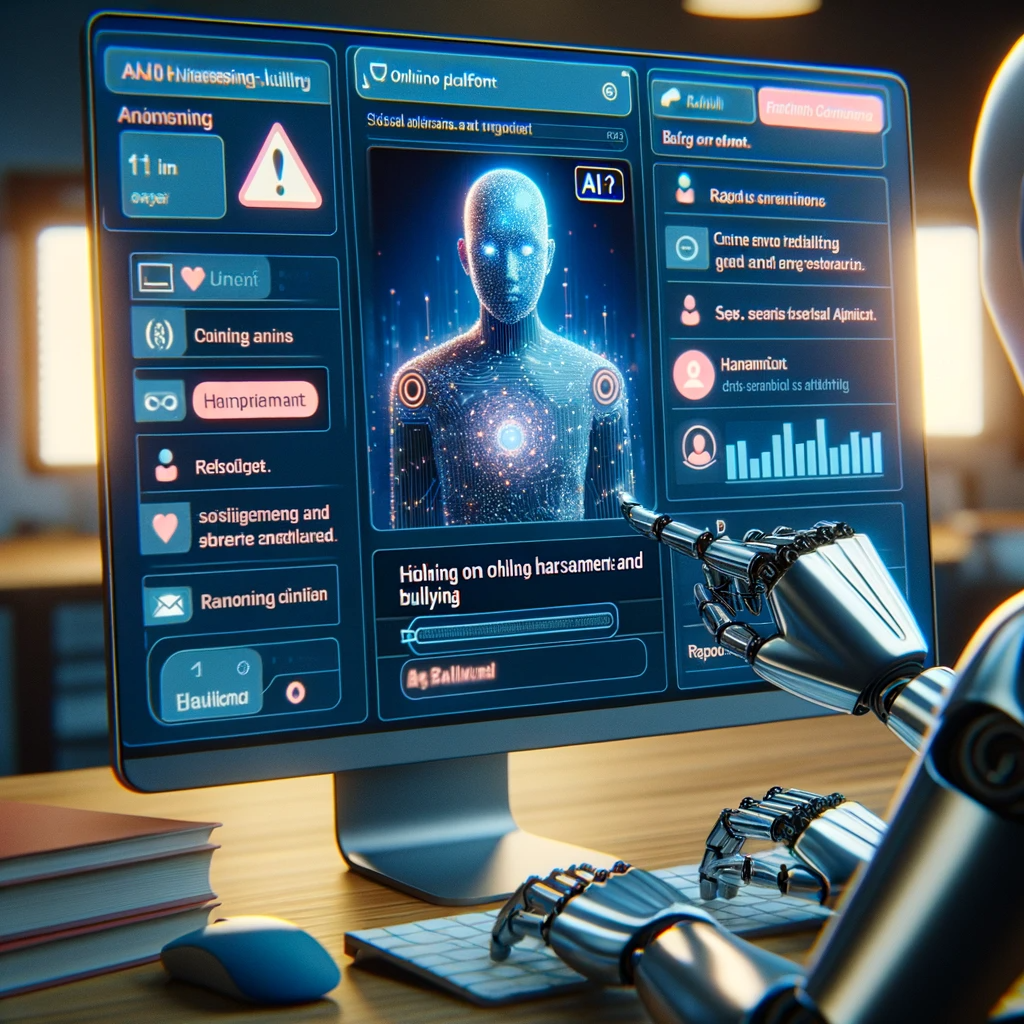In the digital age, the evolution of communication and social interaction has brought with it remarkable opportunities for connection and community-building. However, it has also given rise to a pervasive problem that threatens the safety and well-being of individuals in online spaces: online harassment and cyberbullying. The consequences of these digital behaviors can be devastating, impacting the mental health and emotional stability of victims while contributing to a toxic online culture. As the digital landscape continues to evolve, a crucial question emerges: Can Artificial Intelligence (AI) be harnessed as a powerful tool to identify, combat, and prevent online harassment effectively? This article embarks on a journey into the world of AI-driven solutions, aiming to unravel the potential of technology in creating safer and more inclusive digital environments. Join us as we explore how AI stands at the forefront of curbing online harassment and bullying, shedding light on its capabilities, challenges, and ethical considerations in this ongoing battle for a safer online world.
The Escalation of Online Harassment and Bullying
The Digital Age Dilemma
As we step into the digital age, the internet has become an integral part of our lives, offering unprecedented connectivity and information-sharing capabilities. However, this interconnectedness has also given rise to a disconcerting dilemma—the escalation of online harassment and bullying. What was once confined to face-to-face encounters has now found a virtual home, enabled by the anonymity and detachment the internet provides. This section delves into the roots of this dilemma, tracing the evolution of online harassment and bullying from offline origins to the digital realm.
Impact on Individuals and Society
The consequences of online harassment and cyberbullying extend far beyond the confines of the digital world. Victims often endure emotional distress, anxiety, depression, and sometimes even contemplate self-harm or suicide. Moreover, the negative impact of online harassment ripples through society, contributing to a culture where hatred and intolerance can thrive. This section explores the profound repercussions of online harassment on individuals’ mental well-being and society at large, highlighting the urgency of addressing this issue effectively.
The Role of AI in Identifying Online Harassment
Understanding AI’s Detection Abilities
In recent years, Artificial Intelligence (AI) has emerged as a formidable ally in the fight against online harassment. AI possesses the capability to analyze vast amounts of textual and visual data, allowing it to identify patterns, keywords, and behaviors indicative of harassment and bullying. This section provides an in-depth look at how AI systems are designed to detect potentially harmful content, offering insights into the technological foundations that power this functionality.
Sentiment Analysis and Language Processing
At the core of AI’s effectiveness in detecting online harassment lies the power of sentiment analysis and natural language processing. AI algorithms can assess the emotional tone of text and understand the nuances of language, allowing them to differentiate between innocuous conversations and harmful interactions. This section delves into the mechanics of sentiment analysis and language processing, shedding light on how AI interprets context, intent, and the emotional nuances that are often lost in traditional content moderation.
In the subsequent sections of this article, we will explore how AI-driven solutions are implemented on social platforms, the challenges and ethical considerations that arise, and the role of human moderation in conjunction with AI. We will also examine real-world success stories and case studies, offering a glimpse into the impact of AI in curbing online harassment and creating safer digital spaces. Through this comprehensive exploration, we aim to provide a nuanced understanding of how AI can play a pivotal role in addressing the pressing issue of online harassment and bullying.

AI-Driven Solutions for Social Platforms
Content Moderation
In the battle against online harassment, social platforms have turned to AI-powered content moderation systems as a frontline defense. These systems utilize AI algorithms to scan user-generated content in real-time, flagging and removing potentially harmful material. This section provides an overview of how AI is integrated into content moderation processes, from identifying hate speech and threats to detecting cyberbullying incidents. It also acknowledges the challenges and limitations inherent in automated content moderation.
Real-time Alerts and Reporting
AI can provide users and platform administrators with real-time alerts when potentially harmful interactions occur. Users receive warnings about the content they are posting or engaging with, while administrators are informed of ongoing issues. Additionally, most platforms have reporting mechanisms that allow users to report harassment incidents directly. This section explores how AI contributes to creating safer digital spaces by enabling swift responses and intervention, all while maintaining user anonymity and privacy.
Challenges and Ethical Considerations
Algorithmic Bias
While AI presents a potent solution to online harassment, it is not without its flaws. One prominent concern is algorithmic bias, where AI systems may inadvertently perpetuate discrimination or censorship. This section examines the potential for bias in AI moderation systems and the measures taken to mitigate these biases. It also emphasizes the need for transparency and fairness in AI development.
Privacy and Data Protection
As AI systems monitor user interactions to detect harassment, concerns regarding privacy and data protection arise. Users may worry about their conversations and content being analyzed, raising questions about the ethical use of AI for surveillance purposes. This section delves into the privacy implications of AI monitoring and explores how social platforms balance the imperative of user safety with respect for individual privacy rights.
The Human Element in Moderation
The Need for Human Oversight
While AI plays a crucial role in detecting online harassment, human judgment remains indispensable. This section underscores the importance of human moderators who can provide context-aware assessments and make nuanced decisions that AI systems may struggle with. It highlights the role of human oversight in ensuring that content removals are just and free from false positives.
AI as a Supportive Tool
AI does not replace human moderators; rather, it augments their capabilities. AI can assist human moderators by flagging potential issues, reducing their workload, and improving response times. This section explores how AI and human moderation can work in tandem to create a more effective and efficient system for combating online harassment while respecting freedom of speech.
Success Stories and Case Studies
Examples of AI in Action
To illustrate the practical applications and effectiveness of AI in curbing online harassment, this section showcases examples and case studies from various social platforms. These real-world instances demonstrate how AI systems have successfully identified and prevented harassment, resulting in safer digital environments.
Impact on User Experience
Testimonials and user experiences play a pivotal role in understanding the impact of AI in creating safer online spaces. This section includes quotes and insights from social media users who have benefited from AI-driven solutions. These testimonials highlight how AI contributes to a more positive user experience, encouraging open and respectful dialogue.

Conclusion
In conclusion, the rise of online harassment and cyberbullying presents a profound challenge in the digital age. The potential for AI to assist in curbing these issues is promising, offering a technological solution that can identify harmful content and facilitate swift interventions. However, it is crucial to acknowledge the complexities and ethical considerations that come with implementing AI for content moderation.
AI should not replace human judgment but rather enhance it. Human moderators play a vital role in understanding context and ensuring fair and just outcomes. AI serves as a valuable tool, helping moderators efficiently handle the vast volume of user-generated content and enabling real-time alerts and reporting.
As we look to the future, ongoing developments in AI and collaborative efforts between stakeholders will likely result in more effective and ethical solutions for curbing online harassment. The aim is to create digital spaces where individuals can express themselves freely without fear of harassment or harm.
The answer to whether AI can assist in curbing online harassment and bullying lies in our continued commitment to innovation, fairness, and empathy. As we navigate the digital landscape, it is our collective responsibility to harness the potential of AI while upholding the principles of inclusivity and respect for all users. By doing so, we can create a safer and more harmonious online world for everyone.
